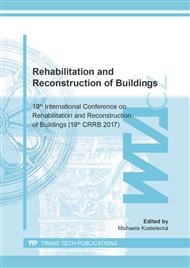p.133
p.140
p.147
p.153
p.160
p.167
p.177
p.185
p.191
Mechanical Fracture Parameters of Extruded Polystyrene
Abstract:
Extruded polystyrene (XPS) is a material with applications in the building industry, where it is typically used as thermal insulation. Fracture experiments in the three-point bending configuration were conducted on XPS beam specimens with an initial stress concentrator made before testing. The nominal dimensions of the beams were 40 × 40 × 160 mm. The depth of the initial edge notch on the bottom side of the specimen was approximately 1/3 of specimen height. The span length was 120 mm. Load vs. displacement diagrams were recorded during fracture tests, and subsequently the modulus of elasticity (E), effective fracture toughness (KIce) and specific fracture energy (GF) of the XPS were determined. The mean values obtained for the mechanical fracture parameters and coefficients of variation (number of specimens) were the following: E = 10.7 MPa, 9.2 % (7); KIce = 0.0547 MPa∙m1/2, 16.7 % (3); GF = 183.2 J∙m–2, 34.3 % (3).
Info:
Periodical:
Pages:
160-163
Citation:
Online since:
August 2018
Authors:
Price:
Сopyright:
© 2018 Trans Tech Publications Ltd. All Rights Reserved
Share:
Citation:


